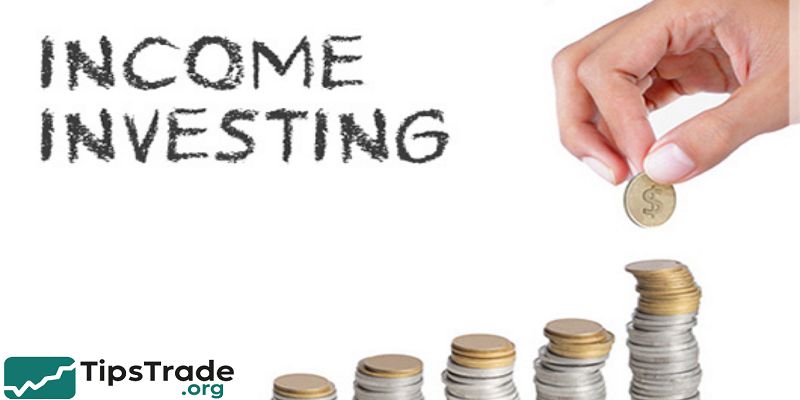Income investing is a strategy that focuses on building a portfolio that pays you steady cash flow—monthly, quarterly, or yearly—through dividends, interest, or rental income. Instead of only waiting for the price of a stock to go up, income investors choose assets that consistently generate money even while they hold them. For beginners, it feels more predictable and less stressful, because the goal is not quick trading, but long-term stability. In today’s uncertain markets, income investing has become popular among retirees, young adults, and even small investors who want passive income without taking excessive risk.
What Is Income Investing?

Income investing is a strategy where the investor builds a portfolio designed to generate regular payouts, rather than relying only on price appreciation. The payments may come from dividends on stocks, monthly rental income from real estate, interest from bonds, or distributions from ETFs.
Unlike growth investing—where investors wait for a stock to rise—income investing creates a stream of money that arrives regardless of whether the market goes up or down. Many financial advisors describe it as building a “money machine” that pays you while you sleep.
For example, if an investor holds a stock that pays a 4% annual dividend, holding $10,000 in that stock would generate $400 per year, without selling anything.
How Income Investing Works
Income investing works on a simple principle: buy assets that produce cash flow. A dividend stock shares a portion of company profits with investors. A government bond pays interest for lending money to the government.
A real estate investment trust (REIT) pays rental income from property portfolios such as apartments, office buildings, or warehouses. Over time, these payments accumulate, helping investors build passive income while keeping their original investment intact.
According to BlackRock research, portfolios that reinvest dividends can grow up to 2X faster over 20 years than portfolios that only depend on stock price increases. This is why many long-term investors, including Warren Buffett, prefer dividend-paying companies—because the compounding effect of reinvested income multiplies wealth.
Capital Gains vs. Income Investing
In growth investing, profit comes from selling an asset at a higher price. For example, if you buy a stock at $100 and sell it at $150, you earn a gain of $50. But you only profit when you sell. Income investors, instead, receive money without selling their assets.
If you hold a dividend ETF or a bond, you can earn monthly or quarterly income while keeping your portfolio intact. This difference is why income investing feels more stable—especially for retirees or cautious investors who don’t want to rely on market timing.
During market downturns, dividend and bond payments often continue, even when prices drop. Historically, according to JP Morgan Asset Management, dividends accounted for 30–40% of total stock market returns over the last century.
Why New Investors Like Income Investing
New investors often find the stock market confusing or risky, and many fear losing money during volatility. Income investing reduces this emotional pressure. Instead of trying to guess price movements, the investor focuses on collecting consistent returns.
For students, employees with monthly salaries, or families saving for retirement, income investing feels safer because it rewards patience.
Another reason beginners like this approach is accessibility—many income assets such as ETFs, savings products, and corporate bonds allow minimum investments as low as $10 to $100. Even small investors can start building passive income without needing thousands of dollars.
Popular Income-Generating Assets

There are many ways to earn passive income from investments. Below are the most common and beginner-friendly options, along with real examples, historical performance, and risks to consider.
Dividend Stocks
Dividend stocks are shares of companies that pay a portion of their profits back to investors. Well-known dividend-paying companies include Coca-Cola, Johnson & Johnson, Apple, Microsoft, and Procter & Gamble.
These are often large, stable companies with long business histories. For example, Coca-Cola has paid uninterrupted dividends for more than 60 years, even during recessions. The average dividend yield for U.S. companies is around 2%, but some sectors such as utilities, telecom, and banking pay 3–7%. Although dividend stocks can fluctuate in price, the steady income helps balance volatility.
For beginners, dividend aristocrats—companies that have raised dividends for 25+ consecutive years—are considered reliable. This category includes Walmart, McDonald’s, and Chevron.
Pros: Long-term growth + passive income
Cons: Prices can drop; dividends are not guaranteed
Bonds
Bonds are loans that investors give to governments or corporations in exchange for interest payments. U.S. Treasury bonds are considered one of the safest assets in the world, because they are backed by the government.
Corporate bonds pay higher interest but also carry slightly higher risk. According to the U.S. Department of the Treasury, 10-year government bonds historically pay 2%–5% annually.
Bonds are popular among retirees and conservative investors who want to protect capital. In 2023, when stock markets were volatile, bond ETFs attracted billions of dollars because investors looked for stability.
The key advantage of bonds is predictable income—investors know exactly how much interest they will receive.
Pros: Stable, low risk, guaranteed interest (for government bonds)
Cons: Lower returns; sensitive to interest rate changes
REITs (Real Estate Investment Trusts)
REITs allow investors to earn rental income without buying physical property. A REIT collects rent from apartments, malls, warehouses, or hotels and pays that income to shareholders. In the U.S., REITs are legally required to distribute at least 90% of taxable income to investors.
That is why many REITs pay high yields—often 4–8% per year. Popular REITs include Realty Income (nicknamed “The Monthly Dividend Company”), Vanguard Real Estate ETF (VNQ), and American Tower.
REITs help diversify a portfolio because real estate does not always move in the same direction as the stock market. For people who want real estate income but don’t have money to buy a house, REITs offer an easy entry point.
Pros: High yields, diversification, passive real-estate income
Cons: Sensitive to interest rates and economic downturns
Dividend ETFs and Index Funds
Many beginners prefer ETFs because they provide instant diversification. A dividend ETF holds dozens or hundreds of income-paying companies.
Instead of choosing one stock, an investor can buy one ETF and receive payouts from many companies at once. Well-known options include Vanguard Dividend Appreciation ETF (VIG), Schwab U.S.
Dividend Equity ETF (SCHD), and SPDR S&P Dividend ETF (SDY). According to Morningstar, dividend ETFs historically earn 2–4% annual yield while offering long-term growth.
Index funds also exist for bonds, REITs, utilities, and international dividend stocks. For someone who wants a simple, hands-off approach, ETFs are often the easiest way to start.
Pros: Diversified, low fees, beginner-friendly
Cons: Yields vary; prices still move with the market
High-Yield Savings & Certificates of Deposit (CDs)
Some investors prefer guaranteed interest with zero market risk. High-yield savings accounts and CDs are common choices.
In 2024, many U.S. banks offered interest rates between 3% and 5% for savings and CDs, depending on deposit size and term.
The benefit: safety. Accounts are insured by the FDIC up to $250,000, meaning money is protected even if a bank fails.
However, these options usually pay less than stocks or real estate. Many investors use them to store emergency funds or short-term savings while still earning interest.
Pros: Extremely safe, guaranteed returns, easy to access
Cons: Lower income compared to stocks or REITs
Benefits of Income Investing
Income investing offers a balanced approach that works for beginners, retirees, and long-term investors who dislike speculation.
Stable and Predictable Cash Flow
The biggest advantage is receiving regular income. Even during market downturns, many companies continue paying dividends.
For example, Johnson & Johnson increased dividends during the 2008 financial crisis, when many stocks fell sharply.
Bond interest also continues regardless of market volatility. Investors who combine multiple asset types—stocks, bonds, REITs, and ETFs—can create monthly or quarterly payments.
This stability is valuable for retirees who depend on income for living expenses, and also for young investors who reinvest earnings to grow their wealth faster.
Protection Against Inflation
Inflation makes money lose value over time. If inflation is 4% and your savings earn 1%, you are losing purchasing power. Income-producing assets protect wealth by increasing payouts or growing in value.
For instance, many REITs raise rents over time, which increases dividends. Many companies increase dividends annually to keep up with rising costs.
Research from S&P Global shows that dividend-growing companies historically outperform non-dividend companies during inflationary periods.
This is why income investing is often recommended during uncertain economies or rising interest rates.
Long-Term Passive Wealth Building
When investors reinvest dividends into buying more shares, their portfolio grows faster due to compounding.
For example, if a $10,000 dividend ETF pays 4% annually, reinvesting the income would grow the holding to over $21,000 in 18 years—without adding new money. If an investor continues contributing monthly, the growth becomes even stronger.
According to a study by Hartford Funds, 84% of S&P 500 returns over the last 50 years came from reinvested dividends.
Passive income helps investors stay patient, avoid emotional trading, and focus on long-term wealth instead of short-term market noise.
Risks You Should Know

Like any financial strategy, income investing has risks. Being aware of them helps investors make smarter decisions and avoid losses.
Market Risk
Dividend stocks and REITs can go down in price during recessions or interest rate changes. Even stable companies can experience short-term declines.
However, long-term data shows that diversified dividend portfolios usually recover and continue paying income.
This is why experts recommend spreading investments across sectors (utilities, healthcare, consumer goods, banking, technology) instead of betting on a single company. Using ETFs can reduce market risk because they hold many stocks at once.
Interest Rate Risk
Bonds, REITs, and savings products respond to interest rates. When interest rates rise, bond prices typically fall. When rates fall, bond prices rise.
REITs also react to borrowing costs—higher interest makes property financing more expensive, which may slow growth. However, these fluctuations are normal and often temporary.
Many long-term investors avoid timing interest rates and instead hold bonds and REITs consistently to collect income through cycles.
Dividend Cuts
A company can reduce or stop paying dividends if business declines. This usually happens when profits fall, debt increases, or cash flow is weak. For example, airline and hotel companies cut dividends during the 2020 pandemic. To minimize this risk, investors often look at the dividend payout ratio (how much of earnings are paid to shareholders). A sustainable dividend usually comes from companies with strong cash flow, low debt, and a long history of payments. Dividend aristocrats and blue-chip companies rarely cut dividends.
Taxes
Dividend and interest income may be taxed depending on local regulations.
Some countries offer tax-free government bonds or special tax treatment for retirement accounts.
Many investors use tax-advantaged accounts—such as IRAs (U.S.) or ISAs (UK)—to grow income without paying immediate taxes.
Understanding tax rules helps maximize net income and prevent surprises later.
How to Build an Income Portfolio

Beginners often ask: “Where do I start?” Below is a simple and practical path used by real investors and financial advisors.
Set Your Financial Goals
Your portfolio will look different depending on your goals:
- Want passive income now? → Focus on high-yield assets like REITs, dividend stocks, and bond funds.
- Want long-term growth? → Choose dividend-growing companies and reinvest payouts.
- Want safety? → Include government bonds and savings products.
Many investors start with a small monthly amount and grow over time. Even $50–$100 per month builds passive income when consistent.
Decide Your Risk Level
- Conservative: More bonds, savings, and low-volatility ETFs
- Balanced: Mix of dividend stocks, ETFs, and bonds
- Aggressive: Dividend stocks + REITs + growth-income ETFs
Age and personality matter too. Young investors often take more stock exposure because they have years to recover from volatility. Retirees prefer stable income and capital protection.
Choose Asset Types
Most professional portfolios include multiple asset classes such as:
- Dividend ETFs (broad market exposure)
- Blue-chip dividend stocks
- Bond ETFs or government bonds
- REITs for real-estate income
- Cash or CDs for security
Diversification allows income to continue even if one category underperforms.
Build Allocation Examples
Here are simple models:
Conservative (low risk)
- 50% bonds and bond ETFs
- 20% dividend ETFs
- 20% REITs
- 10% high-yield savings or CDs
Balanced (medium risk)
- 40% dividend ETFs
- 25% bonds
- 25% REITs
- 10% dividend stocks
Growth-Income (higher return potential)
- 50% dividend stocks
- 30% REITs
- 20% dividend ETFs
These are educational examples—not financial advice.
Reinvest the Dividends
- Reinvesting is the secret to compounding.
- Instead of spending the income, investors use it to buy more shares automatically.
- Many brokers offer DRIP (Dividend Reinvestment Plans), which reinvest earnings at no extra cost.
- Over time, reinvestment accelerates portfolio growth without adding new money.
Use Reliable Platforms and Tools
- Beginners usually choose trustworthy platforms with low fees such as Vanguard, Fidelity, Schwab, Trading 212, or Interactive Brokers.
- Many offer commission-free ETFs and automatic dividend reinvestment.
- Research tools like Yahoo Finance, Morningstar, and Seeking Alpha help track dividend history, stability, and payout ratios.
Example Portfolios
These sample portfolios show how different strategies generate income.
Conservative Portfolio
- 50% in U.S. Treasury and investment-grade bond ETFs
- 20% in dividend ETFs
- 20% in REITs
- 10% in savings or CDs
This portfolio focuses on safety and predictable income. It commonly produces annual yields of 3–4%.
Balanced Portfolio
- 40% dividend ETFs (e.g., VIG, SCHD)
- 25% bonds
- 25% REITs
- 10% blue-chip dividend stocks
Income typically ranges around 4–5% annually while keeping moderate risk.
Growth-Income Portfolio
- 50% dividend stocks
- 30% REITs
- 20% high-dividend ETFs
This portfolio aims for higher yields—sometimes 5–7%—but with more price volatility. Many young investors choose this approach and reinvest payouts to accelerate growth.
Case Studies & Real Examples

Example 1: Long-Term Dividend Growth
If an investor buys $5,000 of a dividend ETF with a 4% yield, they earn $200 per year. If they reinvest earnings and add $100 monthly, the investment grows to more than $33,000 in 15 years, assuming average market performance. Even small, consistent contributions create real income.
Example 2: Real Estate Without Owning a House
Buying physical property is expensive, but investing $1,000 in a REIT ETF gives instant exposure to thousands of rental units. If the REIT yields 5%, the investor earns $50 per year—passively. Over time, as rents rise and dividends grow, income increases.
Example 3: Retirement Portfolio
A retiree with $300,000 in a balanced income portfolio yielding 4% earns $12,000 per year without selling any assets. If the portfolio also grows 4–6% annually, the investor can withdraw income while keeping capital relatively stable.
Common Mistakes to Avoid

- Chasing unrealistically high yields (10–15% yields are often risky)
- Investing in one stock instead of diversifying
- Forgetting taxes or transaction fees
- Selling during market dips out of fear
- Not reinvesting dividends
- Ignoring company fundamentals (cash flow, debt, payout ratio)
Successful income investors focus on long-term consistency, not overnight profits.
Conclusion
Income investing is one of the most beginner-friendly ways to build wealth. It protects capital, generates predictable passive income, and works even during volatile markets. Stocks may rise and fall, but dividends, bond interest, and real-estate income continue to flow. By choosing diversified assets, reinvesting payouts, and staying patient, anyone—regardless of age or salary—can build financial security. You don’t need to be rich to start; you just need consistency.

